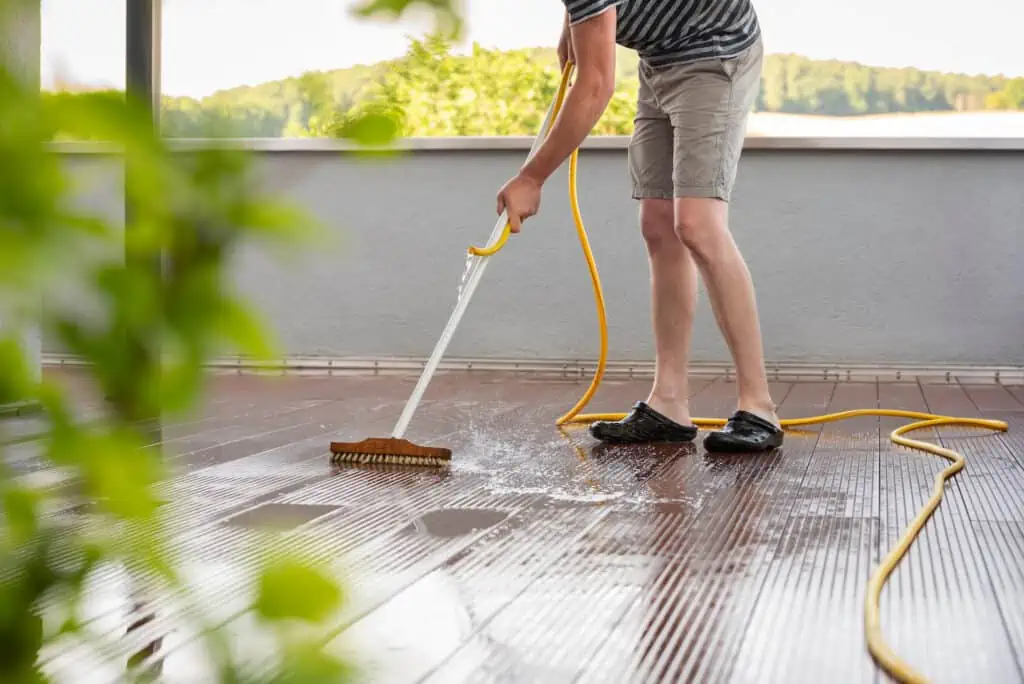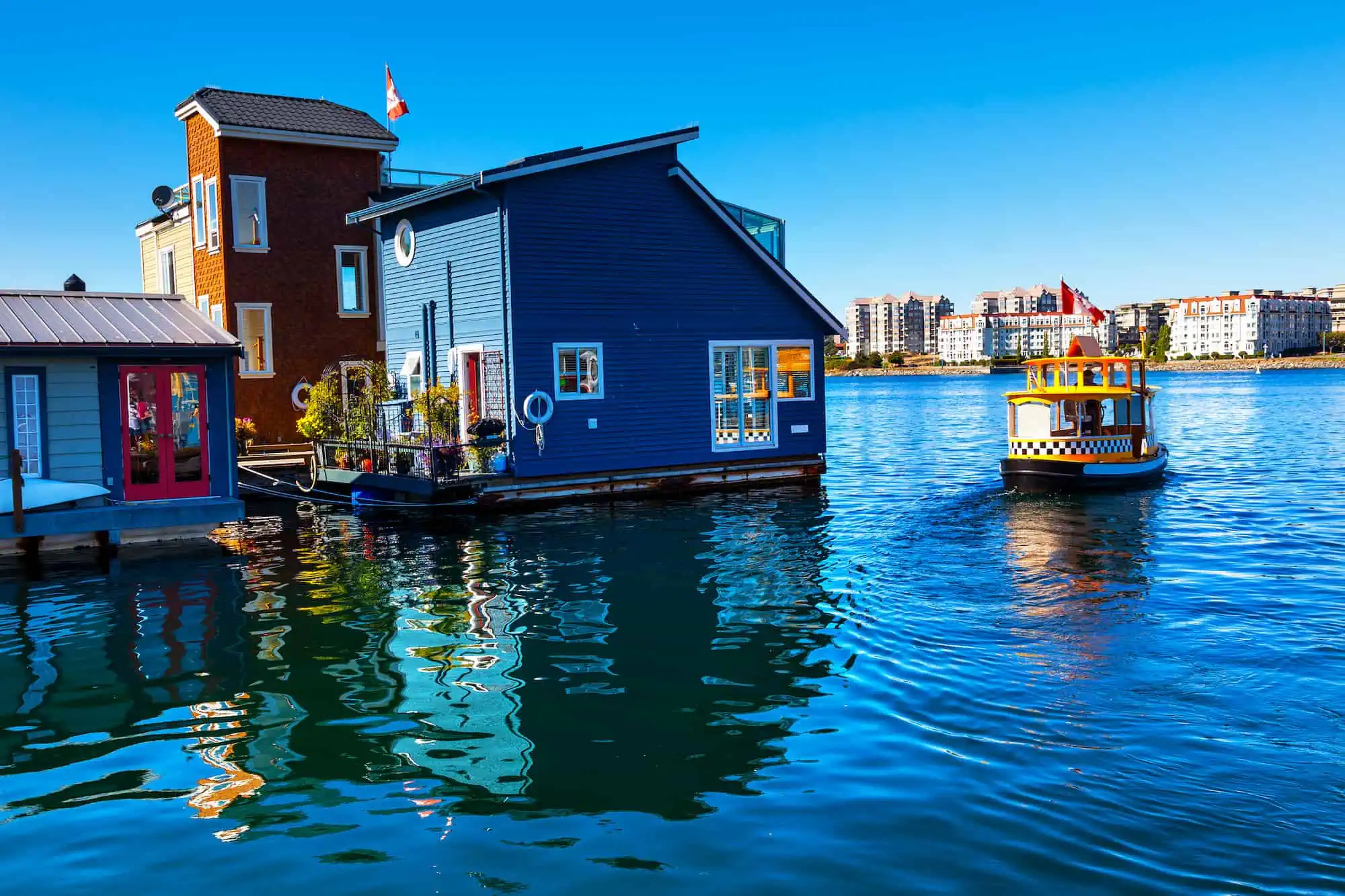Many people dream of owning waterfront property. But maybe you want to take it a step further and actually live on the water. It’s possible with a floating home.
But before you take the leap into this unique living situation, it’s important to consider the potential costs, maintenance needs, and moving logistics first.
Houseboat Vs. Floating Home: What’s The Difference?

Houseboats and floating homes are both dwellings that are designed to be on the water, but they have some distinct differences.
As the name implies, a houseboat is a boat that has been designed or modified to be used primarily as a home. Because it’s a boat, it has its own means of propulsion, like an engine, and can be moved from place to place. Houseboats are typically moored at marinas but have the capability to travel.
“Floating homes often have efficient and innovative design solutions to maximize limited space, which can be great if you’re interested in a more minimalist and organized lifestyle.”
A floating home, on the other hand, is more like a house that floats on the water. It is typically moored or anchored in a specific location and doesn’t move around like a houseboat. Instead, they’re often connected to local utilities like water, sewage, and electricity, similar to land-based homes.
Buying a Floating Home: Things You Need to Know
Are you thinking about moving into a floating home? Here are the key considerations to mull over first.
Budgeting and Financing
Floating homes come with a unique set of costs, both upfront and ongoing. Some of these expenses mirror those of traditional homes, while others are specific to life on the water. Here’s a breakdown:
Upfront Costs
- Purchase Price: The cost of the floating home itself can vary widely based on factors such as location, size, condition, and features. According to Redfin, you may spend anywhere from $30,000 to upwards of $1 million.
- Inspection Fees: Before purchasing, you should invest in a professional inspection from someone experienced with floating homes to ensure there are no hidden issues. In fact, your lender will probably require it. This involves a dive survey to check out the underside of the home, and costs around $600 to $1,000.
- Down Payment: You may need to take out a loan to purchase a floating home. If so, depending on the financing type, the down payment may be higher than what’s typical for land homes.
See prices for local moving labor. Read real customer reviews. Easily book your help online.
Ongoing Costs
- Moorage fees: If you don’t own the slip where your floating home is anchored, you’ll need to pay a fee to rent the space. This can be a significant monthly cost, often around $1,000, which usually covers things like water, garbage, sewage, parking, and maintenance of common areas.
- Homeowner association (HOA) fees: If your floating home is part of a community or marina with shared amenities, you might have to pay HOA fees in addition to the slip/moorage fee.
- Utilities: You’ll likely be responsible for covering the cost of additional utilities, just as you would in a traditional home, including electricity, gas, internet/TV, etc.
- Insurance: Floating homes require a specialized insurance policy that can be pricier than traditional homeowner’s insurance. It’s crucial to have coverage for potential risks such as sinking, flood damage, or storm-related damages. You can expect to pay anywhere from about $400 to $1,800 annually, depending on the total coverage amount for the home, value of the property, personal belongings, and more.
- Financing costs: Floating homes don’t qualify for a traditional mortgage, since they’re considered personal property and not real estate. That means you’ll need a personal property loan, similar to a loan for any other type of boat. Specialized floating home loans also exist; you can usually find them from local banks and credit unions in communities where floating homes are common.
- Maintenance: You need to factor in maintenance costs with any home, but floating homes have special considerations. We’ll get into that more next.
Maintenance and Upkeep
In general, floating homes can be less expensive to maintain than a traditional house. That said, they have specific upkeep requirements that are a lot different from maintaining a house on land.
“Your best bet is to work with a professional moving company that has experience with floating home relocations, as they’ll know the potential challenges and have the necessary equipment to get your move done right.”
It’s crucial to set a regular schedule for inspecting your floating home and performing routine maintenance and repairs. Here are some of the action items that should be on your list:
- The hull: The bottom of your floating home, or its floatation system, is submerged and therefore at risk for wear, water damage, and marine growth. Plus, the hull is usually made of concrete, which can crack. Regular inspections are crucial.
- Corrosion and rust: Any metal parts or fixtures, particularly those near or below the waterline, are susceptible to these issues. Use marine-grade materials when possible and regularly inspect and treat areas showing signs of corrosion.
- Waterproofing: Regularly inspect the exterior of the home for potential water leaks or areas where water could get inside. That includes the roof, walls, windows, and doors. If you do find any leaks, be sure to take care of them ASAP to prevent internal water damage.
- Utility connections: Since utilities like electricity, water, and sewage are typically connected via lines that run to shore or a dock, it’s important to regularly check these connections for wear or damage, especially since the home can move around a bit.
- Anchoring and mooring: Ensure that the home’s mooring lines, anchors, and related equipment are in good condition. Check for wear, chafing, or any signs that a failure could be on the horizon.
- Deck: Decks exposed to the elements can degrade over time, so it’s important to regularly check, clean, reseal or restain, and repair decking as needed.
- Ventilation and humidity: Floating homes can be more susceptible to moisture and humidity problems, which means good ventilation is crucial. You may want to invest in a dehumidifier, or else do your best to increase ventilation in particularly humid climates.
- Pests: Being on the water opens up the possibility of potential pest problems, including rodents and insects. Regularly check for pests and use preventative measures to keep them away, if necessary.
- Safety equipment: Ensure life rings, fire extinguishers, smoke alarms, and other safety equipment are in good working order and replace them as needed.
- Winterizing: If you’re in a location with cold winters, there is the potential for freezing. You’ll need to go through a winterizing process, which includes insulating water lines and possibly using heat tape to keep them from freezing. Floating homes in extremely cold climates might also need a bubbler system or agitator to prevent ice from forming around the floatation system, which could cause damage.
Pros and Cons
Living in a floating home offers a unique lifestyle that can definitely be alluring. However, it also comes with its own set of challenges that you should be aware of before buying. Here are the pros and cons of buying a floating home to consider:
Pros:
- Unique lifestyle: A floating home offers a serene environment, often with unparalleled water views and a sense of connection to nature.
- Community: Many floating home communities are tight-knit with neighbors who share a love for the water and the lifestyle it offers.
- Potential for appreciation: In certain areas, especially where waterfront property is at a premium, floating homes can appreciate in value.
- Less environmental footprint: Depending on the location and setup, floating homes can have a smaller ecological footprint than land-based homes. For example, a floating home can be cooler in the summer, potentially reducing the need for air conditioning. Some floating homes are also designed with sustainability in mind, using technologies like rainwater harvesting, solar panels, and water turbines for energy.
- Space efficiency: Floating homes often have efficient and innovative design solutions to maximize limited space, which can be great if you’re interested in a more minimalist and organized lifestyle.
Cons:
- Maintenance: Floating homes are subjected to the constant wear and tear of water and moisture, leading to potential issues like rust, rot, and mold. Regular maintenance is crucial.
- Financing and insurance: Obtaining a loan and insurance for floating homes can be more challenging and potentially more expensive than for traditional homes.
- Vulnerability to natural elements: Floating homes can be more susceptible to rising water levels, storms, and flooding.
- Utilities: While many floating homes are connected to city utilities, managing services like water, sewage, and electricity can be more challenging than on land. There may also be limitations on internet and TV connectivity.
- Resale potential: The market for floating homes can be niche. Depending on the region and the economy, selling a floating home might take longer than a conventional home.
- Regulations: Floating homeowners may face challenges related to zoning, maritime laws, or changing regulations that can affect moorage rights or the ability to rent out the home.
Tips for Moving Into a Home by the Water

You might be wondering: How is moving into a floating home any different than moving into a home on land? After all, it requires the same process of packing up your belongings in boxes, taping them up and adding labels, transporting everything to your new home (maybe with the help of professional movers), and then unloading and organizing your new space.
Well, there are some considerations that you may not have thought of that you need to know so there aren’t any surprises on moving day.
- It’s wet out there: Depending on your particular home, there may be a slippery dock where it’s easy to lose your balance and drop something into the water. You’ll want to use waterproof packing materials when necessary and take extra care to protect fragile items from falls or water damage.
- Transporting your belongings: Your home might only be accessible by boat, and you’ll need to take a lot of trips back and forth. It might make sense to rent a barge service and move everything across the water in one shot. Some even allow you to drive the moving truck right onto it.
- Weight distribution: Just like in a moving truck, you have to distribute weight evenly in your floating home. Putting too much weight in one area of the floating home can cause it to tip, which may lead to damage over time. Make sure your belongings are evenly distributed from front to back, and side to side.
Your best bet is to work with a professional moving company that has experience with floating home relocations, as they’ll know the potential challenges and have the necessary equipment to get your move done right. The simplest way to find a company with this kind of experience is to look up and contact movers in the area you’re moving to.
See prices for local moving labor. Read real customer reviews. Easily book your help online.
Can Floating Homes Be Moved?
Not easily, unfortunately. Houseboats, which are different than floating homes, come equipped with engines and steering systems that allow them to navigate waterways, and can be moved from one location to another on the same body of water. They also lack permanent connections to utilities that floating homes have.
That said, although they’re not really built for regular travel like houseboats, floating homes can sometimes be towed or pushed to new locations using tugboats or similar vessels. Of course, this process is probably going to be a lot more complex and costly than moving a houseboat.




